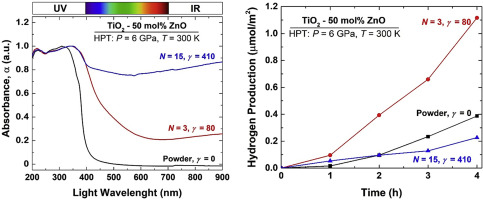当前位置:
X-MOL 学术
›
Int. J. Plasticity
›
论文详情
Our official English website, www.x-mol.net, welcomes your
feedback! (Note: you will need to create a separate account there.)
Phase transformations, vacancy formation and variations of optical and photocatalytic properties in TiO2-ZnO composites by high-pressure torsion
International Journal of Plasticity ( IF 9.4 ) Pub Date : 2020-01-01 , DOI: 10.1016/j.ijplas.2019.08.010 Jacqueline Hidalgo-Jimenez , Qing Wang , Kaveh Edalati , Jorge M. Cubero-Sesín , Hadi Razavi-Khosroshahi , Yoshifumi Ikoma , Dionisio Gutiérrez-Fallas , Fernando A. Dittel-Meza , Juan Carlos Rodríguez-Rufino , Masayoshi Fuji , Zenji Horita
International Journal of Plasticity ( IF 9.4 ) Pub Date : 2020-01-01 , DOI: 10.1016/j.ijplas.2019.08.010 Jacqueline Hidalgo-Jimenez , Qing Wang , Kaveh Edalati , Jorge M. Cubero-Sesín , Hadi Razavi-Khosroshahi , Yoshifumi Ikoma , Dionisio Gutiérrez-Fallas , Fernando A. Dittel-Meza , Juan Carlos Rodríguez-Rufino , Masayoshi Fuji , Zenji Horita

|
Abstract TiO2 and ZnO, two semiconductors with promising optical properties, are considered as potential candidates for solar and photocatalytic applications. Although chemical methods have been primarily used to enhance the optical properties of these oxides, the current authors recently reported enhanced photocatalytic performance of pure TiO2 and ZnO by plastic straining due to the generation of high-pressure phases and oxygen vacancies. In this study, to improve the optical properties further, large fractions of ZnO/TiO2 interphase boundaries are also introduced by application of high-pressure torsion (HPT) straining to a mixture of anatase-TiO2 and wurtzite-ZnO powders. It was found that the amounts of oxygen vacancies and nanograined high-pressure TiO2-II and rocksalt-ZnO phases increase with increasing plastic strain. Moreover, due to the plastic strain effect, the rutile-TiO2 phase is formed at room temperature, which is at least 600 K below the reported anatase-to-rutile transition temperature. These structural features, together with the formation of large fraction of interphase boundaries, lead to electron spin resonance, optical bandgap narrowing, diminishing of the band-to-band photoluminescence and thus, improvement of photocatalytic hydrogen generation. Despite improvements in the photocatalytic activity of TiO2-ZnO composites after large straining, photocatalytic activity becomes poor by processing at ultra-large strains due to the significant reduction in crystallinity.
中文翻译:

TiO2-ZnO 复合材料在高压扭转下的相变、空位形成以及光学和光催化性能的变化
摘要 TiO2 和 ZnO 是两种具有良好光学性能的半导体,被认为是太阳能和光催化应用的潜在候选者。尽管化学方法主要用于增强这些氧化物的光学性能,但最近的作者报告称,由于高压相和氧空位的产生,通过塑性应变增强了纯 TiO2 和 ZnO 的光催化性能。在这项研究中,为了进一步提高光学性能,还通过对锐钛矿-TiO2 和纤锌矿-ZnO 粉末的混合物施加高压扭转 (HPT) 应变来引入大部分 ZnO/TiO2 界面边界。发现氧空位和纳米颗粒高压 TiO2-II 和岩盐-ZnO 相的数量随着塑性应变的增加而增加。而且,由于塑性应变效应,金红石-TiO2 相在室温下形成,比报道的锐钛矿到金红石转变温度至少低 600 K。这些结构特征,连同大部分相间边界的形成,导致电子自旋共振、光学带隙变窄、带间光致发光减弱,从而改善光催化产氢。尽管大应变后 TiO2-ZnO 复合材料的光催化活性有所提高,但由于结晶度显着降低,在超大应变下加工时光催化活性变差。连同大部分相间边界的形成,导致电子自旋共振,光学带隙变窄,带间光致发光减弱,从而改善光催化产氢。尽管大应变后 TiO2-ZnO 复合材料的光催化活性有所提高,但由于结晶度显着降低,在超大应变下加工时光催化活性变差。连同大部分相间边界的形成,导致电子自旋共振,光学带隙变窄,带间光致发光减弱,从而改善光催化产氢。尽管大应变后 TiO2-ZnO 复合材料的光催化活性有所提高,但由于结晶度显着降低,在超大应变下加工时光催化活性变差。
更新日期:2020-01-01
中文翻译:

TiO2-ZnO 复合材料在高压扭转下的相变、空位形成以及光学和光催化性能的变化
摘要 TiO2 和 ZnO 是两种具有良好光学性能的半导体,被认为是太阳能和光催化应用的潜在候选者。尽管化学方法主要用于增强这些氧化物的光学性能,但最近的作者报告称,由于高压相和氧空位的产生,通过塑性应变增强了纯 TiO2 和 ZnO 的光催化性能。在这项研究中,为了进一步提高光学性能,还通过对锐钛矿-TiO2 和纤锌矿-ZnO 粉末的混合物施加高压扭转 (HPT) 应变来引入大部分 ZnO/TiO2 界面边界。发现氧空位和纳米颗粒高压 TiO2-II 和岩盐-ZnO 相的数量随着塑性应变的增加而增加。而且,由于塑性应变效应,金红石-TiO2 相在室温下形成,比报道的锐钛矿到金红石转变温度至少低 600 K。这些结构特征,连同大部分相间边界的形成,导致电子自旋共振、光学带隙变窄、带间光致发光减弱,从而改善光催化产氢。尽管大应变后 TiO2-ZnO 复合材料的光催化活性有所提高,但由于结晶度显着降低,在超大应变下加工时光催化活性变差。连同大部分相间边界的形成,导致电子自旋共振,光学带隙变窄,带间光致发光减弱,从而改善光催化产氢。尽管大应变后 TiO2-ZnO 复合材料的光催化活性有所提高,但由于结晶度显着降低,在超大应变下加工时光催化活性变差。连同大部分相间边界的形成,导致电子自旋共振,光学带隙变窄,带间光致发光减弱,从而改善光催化产氢。尽管大应变后 TiO2-ZnO 复合材料的光催化活性有所提高,但由于结晶度显着降低,在超大应变下加工时光催化活性变差。











































 京公网安备 11010802027423号
京公网安备 11010802027423号